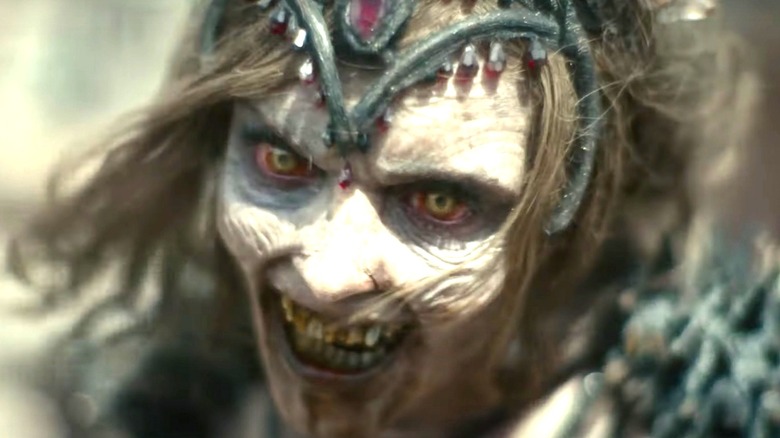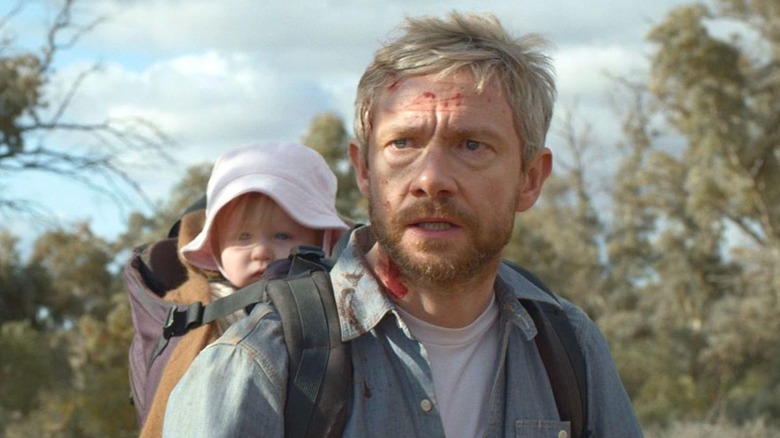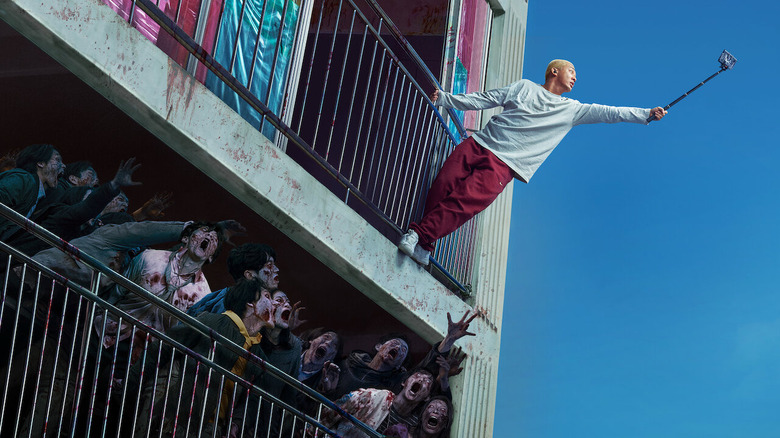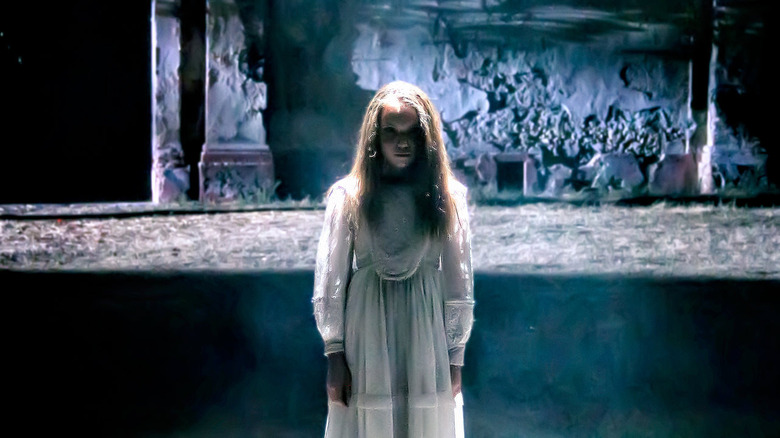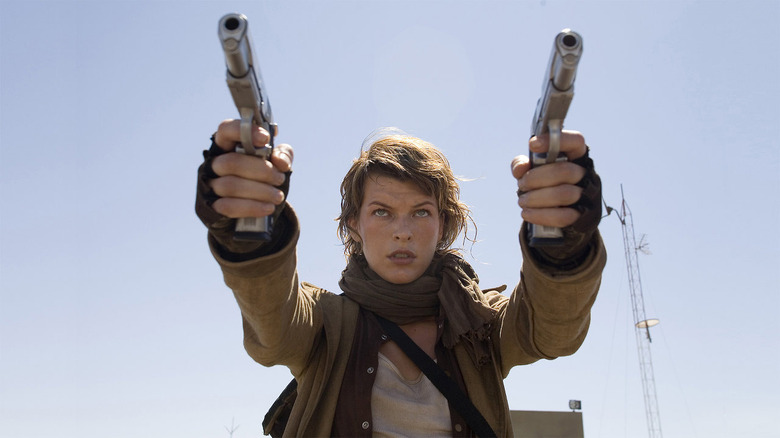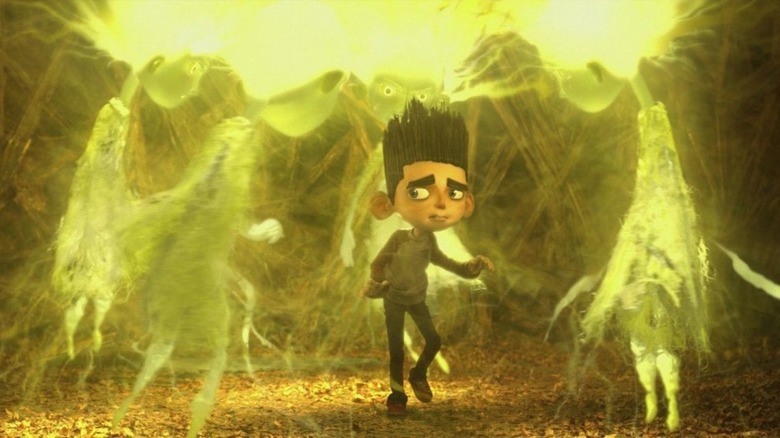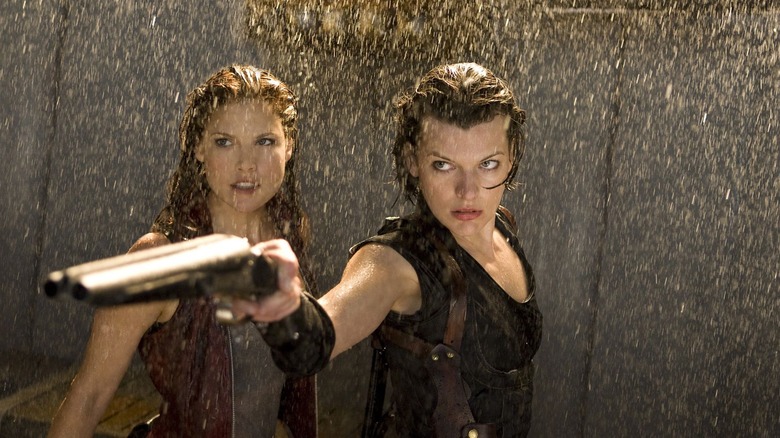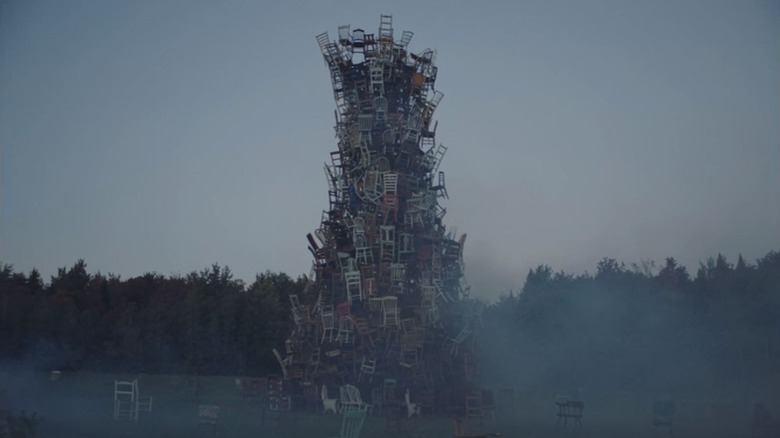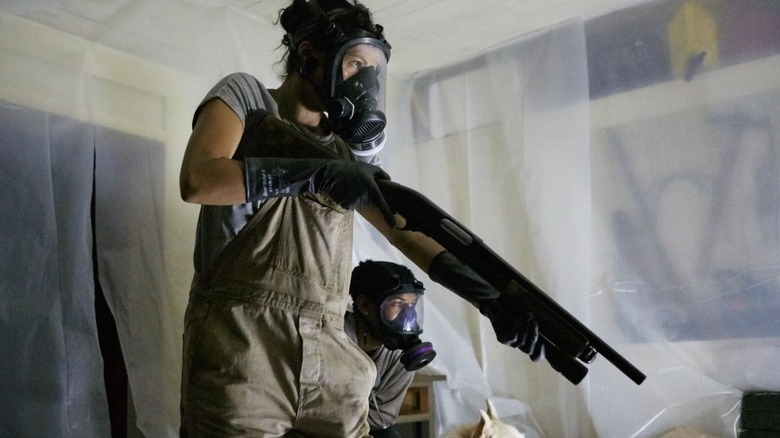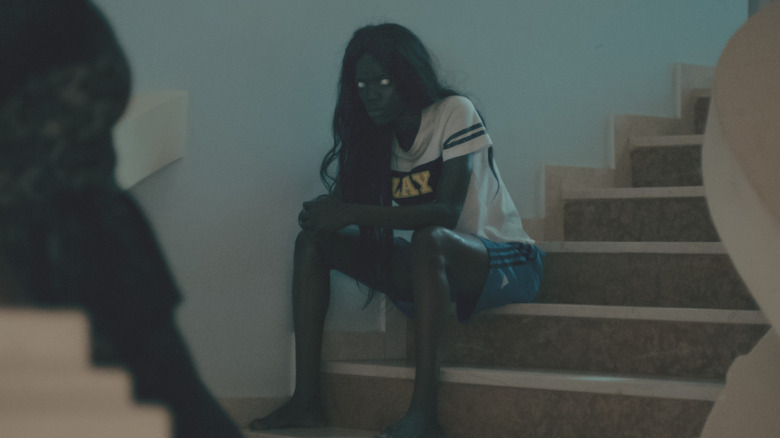The 11 Best Zombie Movies You Can Watch On Netflix Right Now
What is undead will never die — at least, not at the movies. Shambling restlessly out of their graves and into our popular culture's collective unconscious, zombies have endured throughout the decades as an essential horror symbol.
Perhaps we shouldn't be surprised that filmmakers continue to unearth fresh, frightening spins on what amounts to an existential threat. Mass destruction and social decay go hand-in-hand with zombies, whose shiftless masses inevitably overwhelm any semblance of civilization. In corrupting the ideas of death and resurrection, zombies can be read along religious lines as an apocalyptic reckoning. On a socioeconomic level, what is a zombie if not a soulless, braindead consumer, symptomatic of the larger systems that make slaves of us all?
The zombie, in other words, is both a rich, multi-faceted metaphor and also an objectively terrifying concept, even on a surface level. On this list of 11 great zombie movies now streaming on Netflix, you'll find intimate and character-driven dramas, action-packed epics, and even a surprisingly touching animated feature — the spread of which speaks, above all else, to the staying power of the walking dead.
Cargo
Australia's arid Outback serves as the unusually haunting backdrop to a zombie outbreak in Netflix's "Cargo," which takes a restrained, character-driven approach to its central apocalypse.
At the center of this quietly philosophical story is Andy Rose (Martin Freeman, of "Sherlock" and the Hobbit trilogy), who must navigate the dangerous new normal of Australia's zombie-infested interior with his wife Kay (Susie Porter) and infant daughter Rosie. As "Cargo" opens, the trio are traveling down river on a houseboat, running low on supplies and conflicted about where to go next. Through a series of misfortunes, Andy ends up roaming the Outback with Rosie strapped to his back in a race against time to find shelter and evade hordes of ravenous brain-eaters. Eventually, his story intersects with that of a young Aboriginal woman named Thoomi (Simone Landers), who's hiding her infected father from the rest of her community, aware that they plan to track down and exterminate all zombies.
With its red dirt and heat-cracked, sun-scorched earth, there's a primordial mysticism to Australia's interior that's inspired many a cinematic masterpiece, from George Miller's "Mad Max" to Nicolas Roeg's "Walkabout" (the breakout star of which, Australian film icon David Gulpilil, makes a supporting appearance in "Cargo"). As human-sized dramas play out against its endless sprawl, the Outback suggests an elemental collision of civilization and savagery. It's a thematically rich and satisfying location in which to explore a zombie outbreak that frequently forces survivors into morally questionable, potentially soul-corrupting positions.
Army of the Dead
Before DC married his maximal sensibilities to the superhero genre, Zack Snyder delivered one of the great modern zombie movies in 2004's "Dawn of the Dead." Steeped in the thematic subtext of George A. Romero's original, yet faster on its feet, it was a lean, mean, just-right reboot. Everything's since changed for Snyder, and his grand return to zombie horror is suitably scaled up, turning the Vegas strip into a hive of undead depravity.
The opening credits sequence (Snyder's specialty, as fans of "Watchmen" will attest) presents this takeover as a series of slow-motion tableaux: casino patrons hit the jackpot then get ripped apart, an undead Elvis impersonator is crushed by a collapsing replica of the Eiffel Tower, and aircraft explode against skyscrapers as the city descends into chaos. Set to a cover of "Viva Las Vegas" by Richard Cheese (who covered Disturbed's "Down with the Sickness" in Snyder's "Dawn"), the sequence establishes a tone of bitter, nihilistic irony preserved by the film's heist storyline.
As Dave Bautista's haunted mercenary leads a team to lift $200 million from a casino basement, "Army of the Dead" throws all manner of zombie tigers and horses in his path, though the thieves are most imperiled by an undead king and queen, who reign over this bloodthirsty civilization in Sin City's ruins. "Army of the Dead" is Snyder's zombie epic: splashy, sensational, overindulgent carnage on a huge canvas, as only one of Hollywood's most inspired visual stylists could orchestrate.
#Alive
Looking for a zombie thriller that can channel the COVID era's sense of isolation and claustrophobia? Cho Il-hyung's "#Alive" will satisfy that particular craving. Tight as a drum and flavored by fine performances, this small-scale siege picture finds Oh Joon-wo (Yoo Ah-in, best known for his scene-stealing role in "Burning") holed up in his apartment as a mysterious infection tears through the outside world. A video game streamer, Joon-wo initially attempts to sit out the apocalypse, even as his supplies dwindle and his hopes of rescue soon follow.
Close to ending it all, Joon-wo eventually comes into contact with Kim Yoo-bin (Park Shin-hye), a mysterious and dry-witted woman who helps him regain the will to survive. But with zombies swarming the apartment complex on all sides, what kind of life is left for either of these two survivors to lead?
As hinted at by the hashtag in its title, "#Alive" explores the digitized, heavily commodified social realities of Korean millennial culture as much as it does the universal panic and uncertainty of a global pandemic. And through Yoo's committed, emotional lead performance, the film is as much as a character study as it is a horror-thriller. But the real appeal of "#Alive" is in the low-key ingenuity of its execution; Cho, making his feature filmmaking debut, works wonders with drone footage in the film's most heart-in-mouth sequence, and its use of technology feels interwoven with the protagonist's journey in ways spine-tingling and dramatically satisfying.
Ladronas de Almas
In Juan Antonio de la Riva's "Ladronas de Almas" ("Soul Robbers"), insurgents strike out during the Mexican War for Independence in search of lost gold. Happening upon a hacienda populated only by wheelchair-bound owner Agustín Cordero (Ricardo Dalmacci), his lovely daughters Maria (Sofía Sisniega), Roberta (Natasha Dupeyrón), and Camila (Ana Sofía Durán), and Haitian servant Indalesio (Harding Junior), the looters resolve to help themselves to both the treasure and the hacienda's seemingly defenseless women.
But as the insurgents soon discover, these women command an army of the dead, turning an easy conquest into a terrifying battle for survival. A classy and invigorating throwback to the subtle, supernatural chillers that Val Lewton oversaw for RKO Studios in the '40s, "Ladronas de Almas" is most refreshing in its simplicity and remarkably high production values. De la Riva's slick and brooding camerawork, coupled with the film's penchant for evocative shadow play, add an air of lingering, uncanny mystery to the proceedings.
The story, meanwhile, suggests a playful cross between "The Beguiled" and "I Walked with a Zombie," even as stagey performances and special effects heighten the film's melodramatic feel. Ultimately, "Ladronas de Almas" feels most like an extended episode of an forgotten Mexican soap opera, or a lost relic of the country's mid-20th century boom, when the likes of Fernando Méndez, Rafael Baledón, and Chano Urueta were ushering in a golden age of horror, inspired by both RKO's black-and-white chillers and Hammer's gorier gothics.
Kingdom: Ashin of the North
Netflix's South Korean period horror epic "Kingdom" is one of the very best television series to emerge from the peak-TV zombie craze first precipitated by AMC's "The Walking Dead." Set in Korea's medieval Joseon period, "Kingdom" channels all the palace intrigue of "Game of Thrones" without its rushed later-season plotting; at least initially, "Kingdom" centers on the efforts of Crown Prince Lee Chang (Ju Hi-hoon) to determine the source of an unnatural plague that's turning his dead countrymen into reanimated corpses.
Filled with fierce sword-fighting, period-accurate costuming, and genuinely terrifying zombie action (these undead ravagers are nocturnal and move ferociously fast to attack their prey), "Kingdom" is an epic new take on the zombie mythos. Even better is feature-length spinoff "Kingdom: Ashin of the North," which tells the story of a mysterious woman (Jun Ji-hyun) whom Lee Chang encounters at the end of the show's first season.
Dark and thrilling, "Ashin of the North" is a standalone war epic and a fascinating villain origin story, focusing on Ashin's discovery of a resurrection flower that can bring the dead back to life, as well as the systemic mistreatment she endures as a second-class citizen in Joseon's borderlands. After Ashin (played as a child by Kim Shi-a) survives a vicious slaughter that wipes out her family, she dedicates herself to the art of vengeance, becoming a master archer and traveling down a path that will ultimately transform the kingdom forever.
Resident Evil: Extinction
In the third "Resident Evil" installment, Milla Jovovich's kinetic action heroine Alice battles her way across the Mojave Desert in hopes of escaping the post-apocalyptic wasteland that is the continental United States. Specifically, she's set her sights on a safe haven in far-away Alaska. But when the villainous Dr. Isaacs (Iain Glen) tracks Alice down near Las Vegas, he brings the zombie apocalypse to her, forcing Alice to launch a counterattack against the evil Umbrella Corporation. Inspired by George Miller's "Mad Max" and other such dystopian road epics, "Extinction" pits Alice against zombified dogs (in an early sequence indebted to "The Hills Have Eyes") and bloodthirsty zombie crows (a twisted homage to "The Birds"), as well as the requisite hordes of mutated, humanoid undead.
"Resident Evil" is the horror franchise most overdue for a critical reappraisal, and two of its installments appear on this list. "Extinction" is one of only two entries not helmed by series architect Paul W.S. Anderson (who just wrote the script this time around), though director Russell Mulcahy brings to the table the same technical bravura and surreal visual aesthetic he previously pioneered across the "Highlander" films and "Ricochet," not to mention countless '80s music videos. Standing in contrast to the claustrophobic industrial confines that dominate Anderson's "Resident Evil" films, "Extinction" is a surprisingly expansive, ambitious mid-franchise entry, and is all the better for it.
ParaNorman
Laika, the award-winning stop-motion studio behind "Missing Link" and "Kubo & the Two Strings," delivered a Halloween classic with 2012's "ParaNorman." Laika's second feature, following 2009's masterfully morbid "Coraline," is set in the small town of Blithe Hollow (modeled after creaky colonial burgs like Salem, Massachusetts) and follows a young boy who sees dead people. Rather than recoil from this ability, Norman (voiced by Kodi Smit-McPhee) has embraced it, carrying on a friendship with his deceased grandmother (Elaine Stritch) and other friendly neighborhood ghosts. When a witch's curse causes the dead to rise, terrorizing clueless townspeople, it's up to Norman and his allies (including his sister, voiced by Anna Kendrick, and a cheerfully dim jock played by Casey Affleck) to save the day.
Laika's handcrafted animation, overseen by directors Sam Fell and Chris Butler, grows evermore dazzling as "ParaNorman" guides its characters around town and into a dark forest, where they must contend with hordes of the undead as well as a young witch (Jodelle Ferland) and an angry mob. More enthusiastically comical than "Coraline," yet shot through with much of the same eerie beauty, "ParaNorman" is a marvelous stop-motion contraption: spooky enough to scare the kids, but never gruesome enough to wipe the awestruck smiles off their faces. And it's through the film's menagerie of macabre characters, from slack-jawed zombies to ectoplasmic specters, that Laika's artists set their imaginations most free to play. An ode to the monster movies of yore, "ParaNorman" is wickedly smart and endearing.
Resident Evil: Afterlife
"Resident Evil" stalwart Paul W.S. Anderson returned to helm the fourth entry in the series, a direct sequel to "Extinction" and the first installment in the franchise to utilize slow motion and 3D. No extraneous follow-up, "Afterlife" resuscitates "Resident Evil" in style, launching a new trilogy even as Anderson exploits the stereoscopic format to bring audiences virtually inside his frame. Hasty post-production conversions to 3D became increasingly common throughout the 2010s; this wasn't the case with "Afterlife," a film Anderson crafted to feature endless tunnels, elevator shafts, and vast landscapes specifically so that his camera rig could make each one burst off the screen.
All the "Resident Evil" movies are chase films, as Alice (Milla Jovovich) sprints through a booby-trapped, zombie-infested setpieces with the tactical efficiency of a game piece navigating a deadly board. "Afterlife" follows in that tradition, with Alice darting between the smoldering ruins of a post-apocalyptic Los Angeles and eventually coming face-to-face with Albert Wesker (Shawn Roberts), monstrous head of the Umbrella Corporation.
Along the way, Anderson executes many of the franchise's best action sequences, from an acrobatic opening raid on Umbrella's Tokyo headquarters to the climactic fight against Wesker, which includes a sensational beat involving falling glass, Alice's high kick, and a mutated zombie dog. But look to the film's bathroom brawl, in which Alice and Ali Larter's Claire Redfield square off against a brawny Axeman, for a prime example of Anderson's direction firing on all cylinders, spatially positioning audiences inside his viscerally kinetic mayhem.
Ravenous
Canadian zombie thrillers are all the rage these days, from Jeff Barnaby's Indigenous horror-thriller "Blood Quantum" (available on Shudder) to Bruce McDonald's witty, small-scale "Pontypool" (available on Sling). One of the very best on Netflix is Robin Aubert's conceptually bold and tonally assured "Ravenous", a reimagining of zombie-apocalypse thrillers in which a group of eccentric Quebecois survivors hide out from undead hordes in the once-bucolic countryside.
Across its first hour, "Ravenous" unspools as a series of interconnected vignettes, as disparate survivors haphazardly move through civilization's remains in hopes of finding a theoretical safe haven. Lost in the woods, an elderly man (Luc Proulx) mourns the infected family members he shot. In a nearby village, a businesswoman (Brigitte Poupart) unlocks her inner slayer. Elsewhere, a young woman (Monia Chokri) defiantly soldiers on through the landscape, accordion in hand. Gradually, these characters intersect and form a rag-tag unit, with a self-styled hero (Marc-André Grondin) leading them toward one last stand at a remote farmstead.
Scary, melancholic, and rewardingly meditative, Aubert's genre-bending vision of a zombie apocalypse is rife with surreal touches, such as the unnerving piles of furniture stacked high by the walking dead. Could these zombies retain some vestige of their humanity? Through these immense stacks, are they memorializing what they once were? In its elliptical, spiritually minded style, the film is as inspired by cinematic masters Robert Bresson, Andrei Tarkovsky, and Michelangelo Antonioni as it is the political, dramatically forceful horror of George A. Romero's "Night of the Living Dead."
It Comes At Night
Trey Edward Shults emerged with the agonized family portrait "Krisha" before cementing his status as a premier chronicler of such scenarios with "It Comes at Night" and "Waves," two equally foreboding and emotionally seismic studies of families in crisis. Still his most unsettling work, "It Comes to Night" grafts the painful truths about familial bonds under pressure onto a post-apocalyptic setup, making for one of the most effective horror films in recent years.
After an infectious disease sweeps across the globe, one family — husband Paul (Joel Edgerton), wife Sarah (Carmen Ejogo), and son Travis (Kelvin Harrison, Jr.) — hides out at a remote house deep in the woods. Although they're insulated from the plague, fear has crept into this family structure, with Paul wielding authoritarian power over their new normal in hopes of keeping everyone alive. When Will (Christopher Abbott) breaks into the house seeking refuge for his family, Sarah convinces Paul to spare his life. But once Paul reluctantly allows Will, his wife Kim (Riley Keough), and his young son Andrew to stay with them, Travis forms a bond with Kim that puts his father on edge.
Paul's paranoia fuels "It Comes at Night," as Shults turns the insides of this supposed sanctuary into a waking nightmare. Dread-soaked atmosphere, dead-eyed zombies dribbling black bile from their mouths, and the deep-seated terror of a family turning against itself all factor into the film's inexorable, unshakeable sense of tension.
Atlantics
A ghost story so gorgeously enigmatic it appears to slip through one's fingers even as it lingers in the mind, "Atlantics" is extraordinary. That the film is the debut feature of French-Senegalese filmmaker Mati Diop only makes its lyrical tone more breathtaking. Blending unsparing class critique with doomed romance, magical realism, and images of startling beauty, it's a hauntingly powerful work by a formidable artist.
Set in Dakar, Senegal, "Atlantics" focuses on Ada (Mama Sané), who's engaged to marry wealthy suitor Omar (Babacar Sylla) but remains enamored of Souleiman (Ibrahima Traoré), a construction worker owed four months' wages by his exploitative boss (Diankou Sembene). Souleiman sets off into the North Atlantic, one of countless refugees fleeing the coastal city of Dakar in hopes of securing a better future; it's later reported that his boat has capsized with no survivors. But Souleiman isn't gone, not entirely; as a fire ruins Ada's wedding and an unexplained fever spreads through Dakar, Ada's mourning takes on supernatural dimensions.
To say more would be to deny "Atlantics" the staggering force of its most surprising moments, but it's worth noting that the film is out to return the concept of the zombie to its roots as a symbol of the African diaspora. All that folklore of bodies forcibly dispossessed of their souls, condemned to wander the earth, is reclaimed by Diop's film, which turns the undead into avatars of justice, enacting a supernatural reckoning on those who once drove them into the sea.
